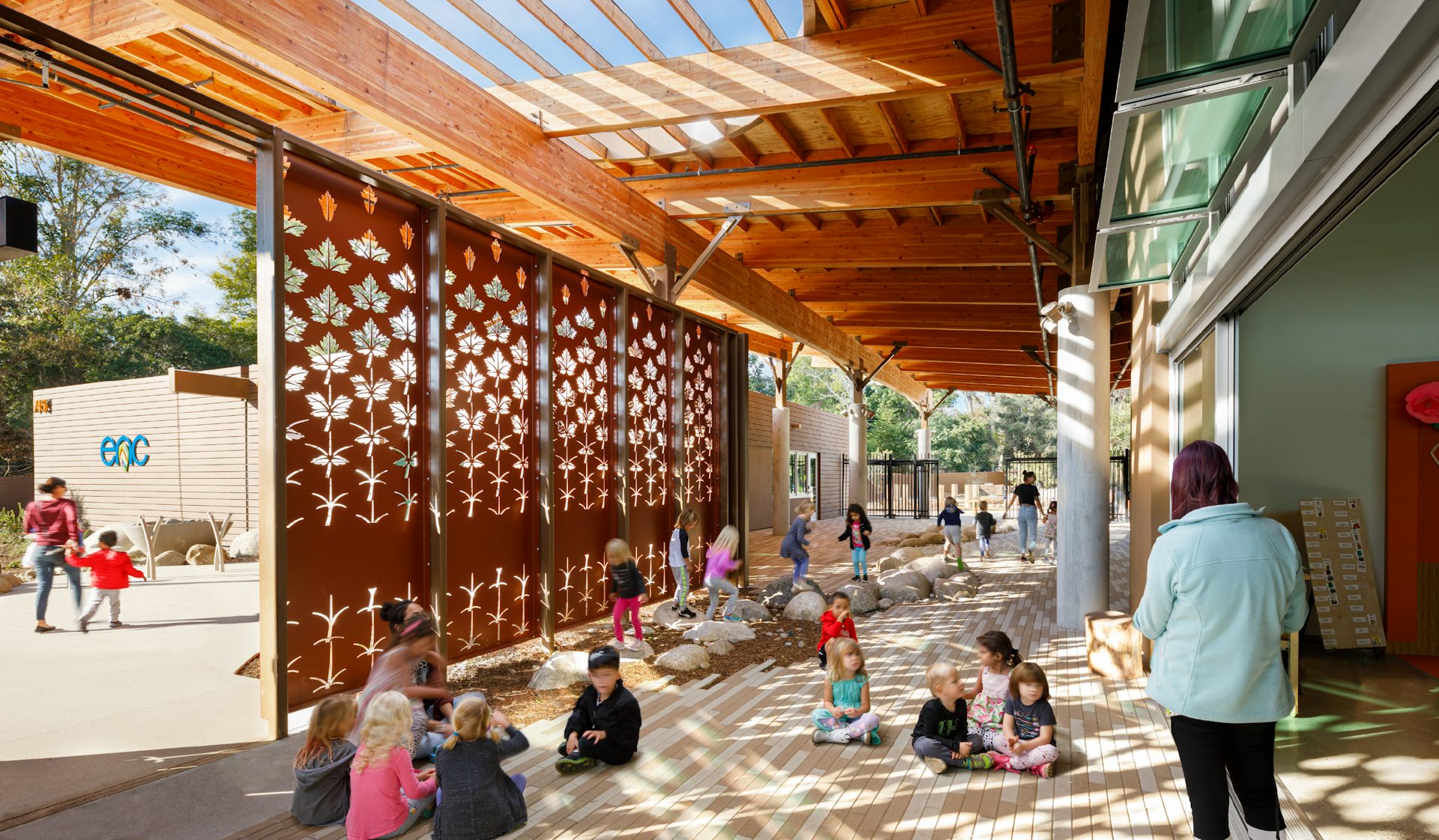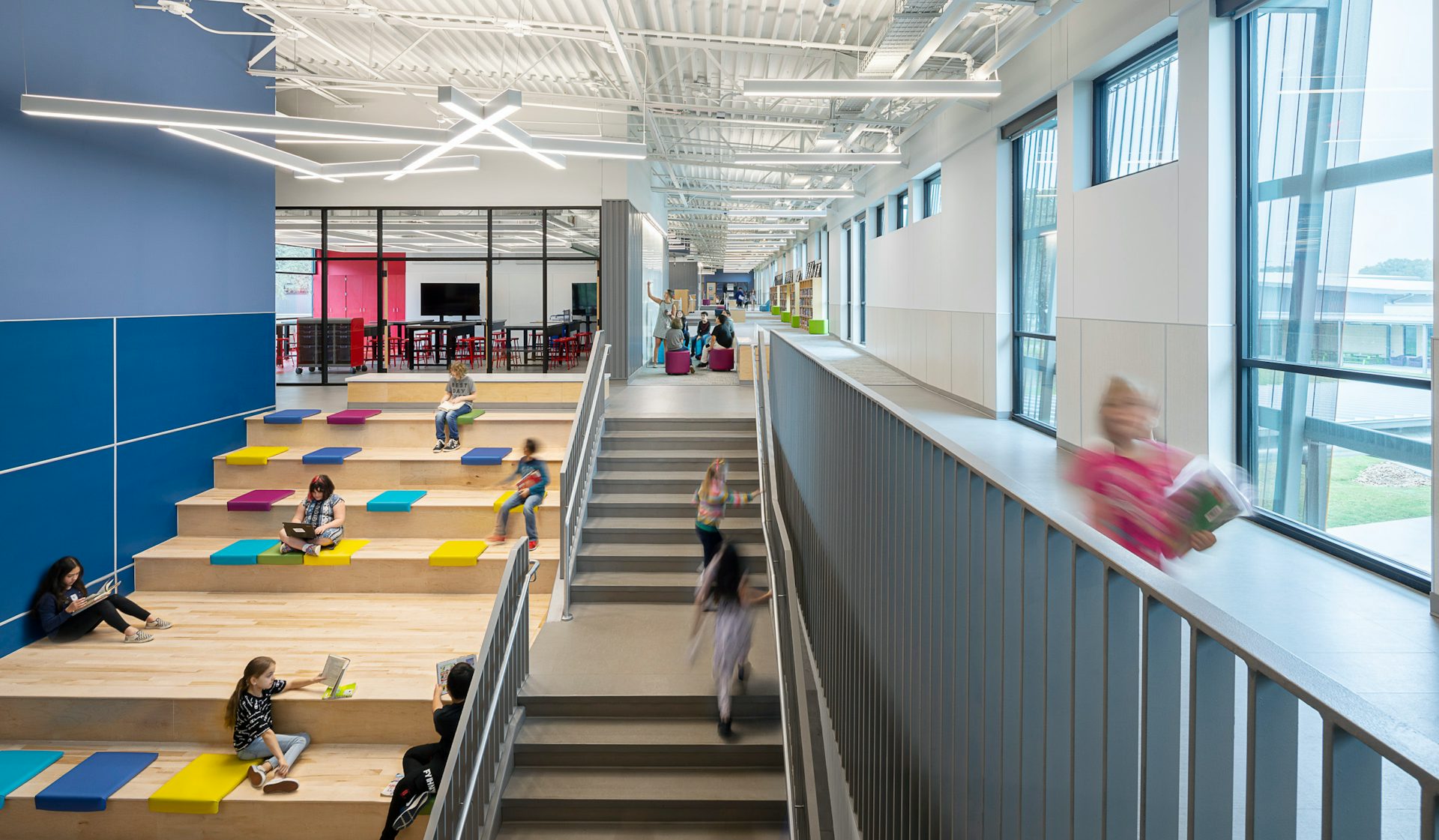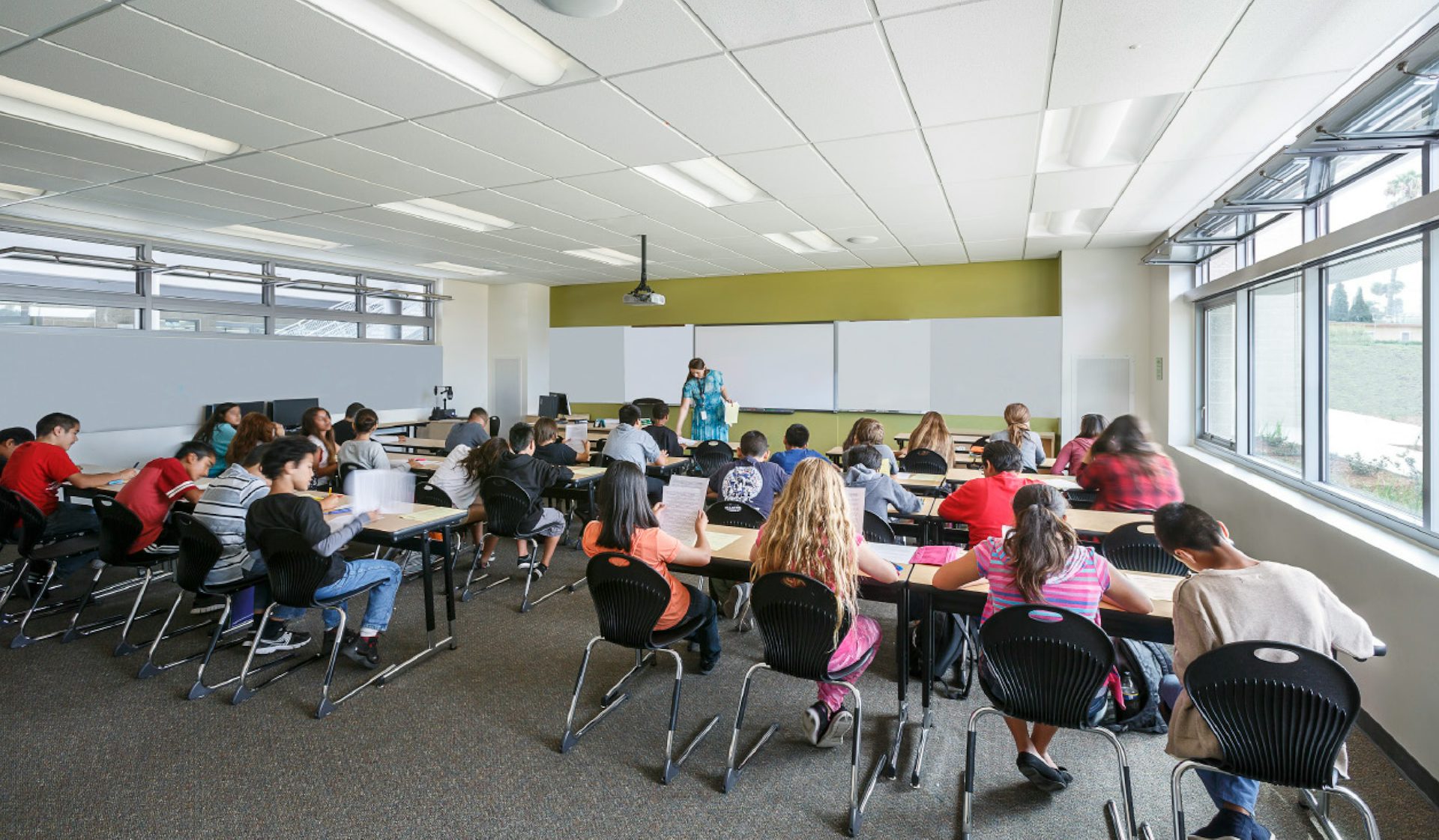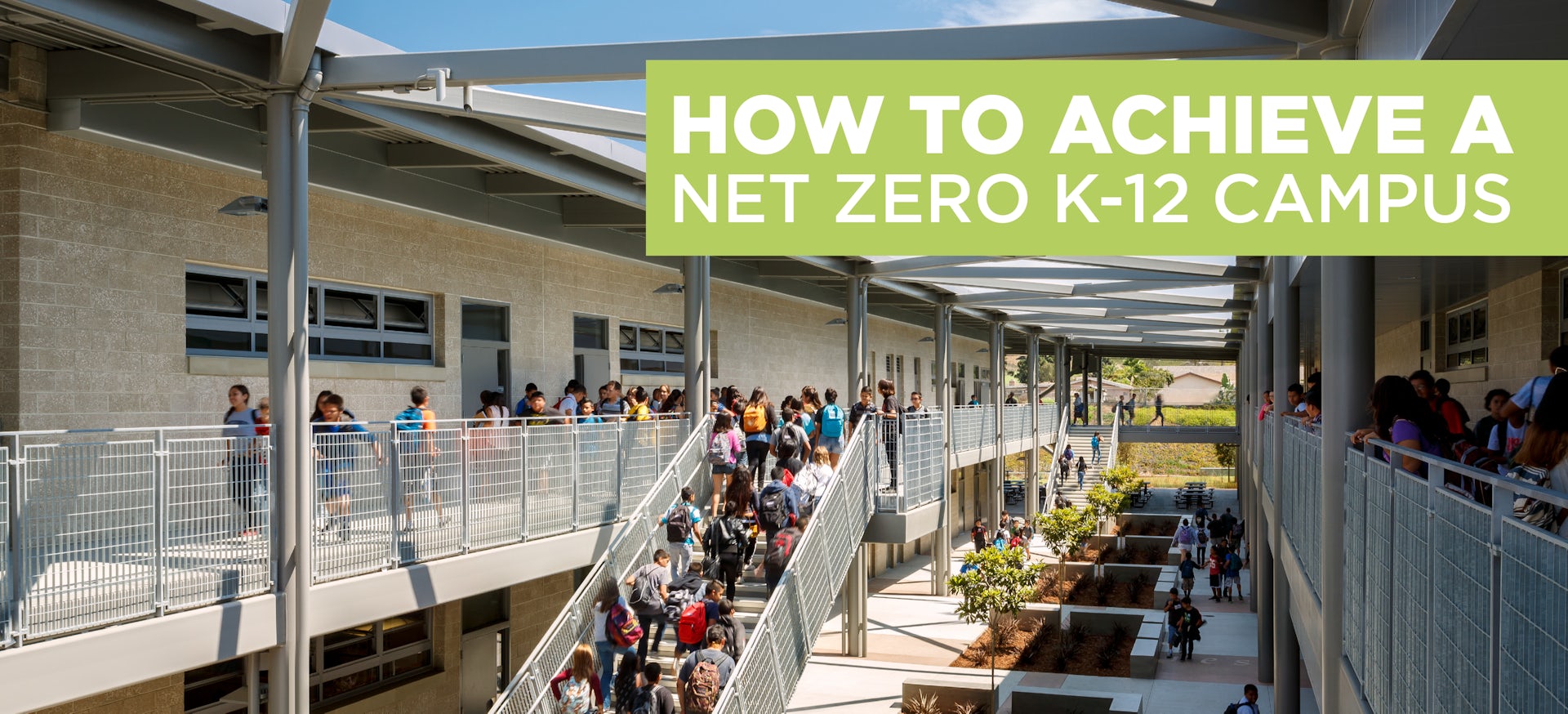When Sweetwater Union High School District (SUHSD) opened a $21-million addition to Montgomery Middle School in 2013, the LPA-designed facility was the first LEED Platinum-certified school in California — and it illustrated how a public school could build net zero classrooms. The 37,500-square-foot facility, including 18 classrooms, a library and cafeteria, was designed to reach the target using a variety of passive and technology strategies, in addition to photovoltaic panels to offset 100 percent of the facility’s reduced energy use.
“Public schools can achieve net zero,” says LPA Design Director Helen Pierce. “But it needs to be baked into every aspect of the design.”
School districts are wrestling with the increasing push toward net zero energy facilities. For many, it’s a complex discussion, touching on everything from construction budgets to education priorities to community priorities. Even the term “net zero” is confusing and used in different ways. (In most cases, net zero energy refers to a highly energy-efficient building with output from on-site renewable energy sources equal to overall annual energy consumption.)
But net zero is achievable within the constraints and challenges of a public school district. Even for a modernization, it’s possible to cut energy use and add renewable sources that meet the sustainability targets and support learning outcomes. Research supports the connection between a focus on sustainability and healthier campuses that support students in many ways, leading to improved learning outcomes.
“School buildings need to be inspiring, effective and safe,” says Erik Ring, LPA’s Director of Engineering. “High energy performance is a goal that we strive to achieve, but it can never be the only thing we’re trying to achieve.”
How to Achieve a Net Zero K-12 Campus
Cutting fossil fuel use on school campuses won’t be easy. But a holistic approach can achieve sustainability goals — and create long-term benefits for educators and students.

An Integrated Approach
The drive for a net zero school doesn’t have to be a budget-draining experience. Some construction firms estimate the cost premium for net zero versus a typical school is only two percent, and the savings in energy costs often pays back the price of additional energy-generation equipment within a decade. U.S. schools spend more of their budgets paying for electricity and natural gas than they do buying textbooks and computers, according to a recent U.S. Department of Energy report.
The investment in net zero “is not a cost premium; it should be viewed as cost avoidance,” helping to reduce operating costs while increasing learning opportunities, says LPA Design Director Kate Mraw. “Imagine the opportunity to reallocate funds for educational purposes.”
Renovating existing schools to achieve net zero might seem like a quixotic quest, like grafting a touchscreen display into a Model T. But many schools already feature layouts that support such a shift, Pierce says. Traditional single-story classroom buildings with single-loaded corridors already have the right bones and can be converted relatively easily, she says.
The design process always focuses on reducing the energy load. “Grounding any project in design solutions that lean on decreasing energy usage reduces the need to produce energy, which reduces costs as well as maintenance and upkeep,” Pierce says.
Building the right amount of space to meet the district's needs is the best sustainability strategy.

To start, schools should perform a thorough assessment of a building’s current energy usage. A net zero energy goal means that retrofits are often shaped both by the state of the existing building and the need to upgrade systems; the least energy-efficient schools have the most to gain by upgrading. This evaluation, along with a calculation of a site’s energy-production potential from sources such as geothermal heating and solar energy, helps to determine feasibility, project scope, funding methods and budgets.
In general, remodeling often means improving key building systems: changing lighting to LED lighting and adding occupancy sensors and daylight sensors that connect to dimmable lighting and automated window shades to maximize the benefits of daylighting. Adding exterior shading devices at windows cuts down on solar gain. Upgrading HVAC systems to include technologies like heat pumps and radiant heat and installing more efficient appliances and electrical devices can cut operating costs. Improving the building’s envelope and using operable windows to take advantage of natural ventilation can also have a significant impact. Existing school sites will often require new electrical utility service, especially for those planning to install solar panel arrays to offset energy use.
In some cases, the traditional large, flat school roof can provide space for photovoltaic systems. If rooftop solar isn’t an option, solar panels over parking lots can provide enough square footage for significant energy generation. For financially stretched districts, modernization projects can create a solar-ready facility, with panels to be added later. In many areas, power purchase agreements (PPAs) with private companies can eliminate the cost of installation, allowing schools to pay back the initial cost over time with proceeds from energy savings, quickly locking in long-term utility savings without upfront investment or the need to maintain solar infrastructure.

New Strategies
Designing a ground-up campus comes with some additional choices and opportunities, especially around orientation, layout and envelope. On new-build projects, strategies such as wood/mass timber construction can also offset the embedded carbon that comes with building.
New facilities designed through an informed, multidisciplinary approach can also link energy efficiency with larger campus goals, incorporating extensive outdoor learning opportunities as well as finding new efficiencies within the building. LPA’s design for Menchaca Elementary School in Austin, Texas, a series of three buildings set amid outdoor play spaces and heritage oak trees, offered exterior circulation, gardens and extensive use of outdoor classrooms. The school’s overall energy use was reduced by 53 percent from a baseline, primarily through passive measures such as building orientation, shading and strategic use of natural light.
Grounding any project in design solutions that lean on decreasing energy usage reduces the need to produce energy, which reduces costs as well as maintenance and upkeep.

“Building the right amount of space to meet the district’s needs is the best sustainability strategy,” Ring says.
LPA’s LEED Platinum, net zero Environmental Nature Center (ENC) Preschool in Newport Beach, California, provides a roadmap for how a facility can take advantage of the site’s gifts to cut energy use. Natural ventilation and building orientation dramatically reduced energy usage in an indoor-outdoor learning space designed with the cognitive development of young children in mind. The facility’s butterfly roof allows natural light and is pitched and sited to support a solar array. It also channels rainwater through a series of rock basins and bioswales, turning a rain shower into a learning opportunity.
In 2020, the ENC earned an AIA COTE Top Ten Plus Award, the industry’s highest honor for sustainable design. The “plus” designation recognizes COTE winners that have already proved their efficiency over time.
For Montgomery Middle School, in Chula Vista, California, LPA’s design started by realigning the school into two elongated bars of classrooms, which enabled daylight and natural ventilation from both sides of the building and formed a shaded courtyard. The design mixed common sense passive designs — such as a light-colored angled rooftop and hardscape surfaces to reduce the building’s urban heat island effect — with strategic technology, including a campus-wide Energy Management System and a thermal displacement ventilation system.
When the school opened, a SUHSD board member proclaimed: “We’re saving money, we’re saving resources, we’re saving our planet, and, at the same time, we’re providing the best-quality education for our students.”

Real ROI
The Montgomery campus includes signage calling out the green design elements, a strategy LPA has employed on several campuses. When the actual systems are on display, sustainable strategies become learning tools.
“The transition from a traditional to net zero school creates a demonstration tool for environmental education and has been shown to lead to more pro-environmental attitudes and behaviors,” Mraw says.
While net zero is good for the pocketbook in the long run, research shows that other outcomes that go with it, such as increased air quality, better ventilation and increased daylighting, greatly improve student performance from day one. One study (Barrett, Davies, Zhang & Barrett, 2015) found that 16 percent of the variation in learning progress can be attributed to physical environments in primary schools, highlighting a direct correlation between physical space design and improvements in student progress in core subjects such as reading and mathematics. A more sustainable campus has been shown to bolster wellness, create more hands-on learning opportunities and serve as a living lab for inquiry-based learning activities.
Beyond the benefits to the campus, our communities and the planet, moving to net zero simply makes financial sense. Reducing energy usage translates to lower operating costs. In many cases, that means more money that can be spent supporting students, which is the fundamental goal of every educator.















